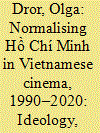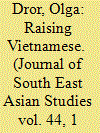| Srl | Item |
| 1 |
ID:
188741


|
|
|
|
|
| Summary/Abstract |
The article discusses the representation of Hồ Chí Minh in modern Vietnamese cinema from 1990 to the present. The first feature film on Hồ Chí Minh's life was produced only in 1990, 31 years after his death. Since then, 6 more films have appeared. I explore the reasons why there were no feature films about Hồ Chí Minh before 1990 and why they eventually began to appear. I address the filmmakers’ attempts to reintroduce Hồ Chí Minh, especially to younger generations who know of him only through propaganda depicting him as a celibate paragon of virtue and through viewing his embalmed body in the Mausoleum he had objected to. I argue that these cinematographic projects to promote Hồ Chí Minh to younger Vietnamese have done very little to develop, or even maintain, his personal cult, a cult that the state endeavours to exploit to (re)establish its connection to the people, to overcome a prolonged crisis of legitimacy, and to garner popular support for the continuing leadership of the Vietnamese Communist Party. The market economy and openness to the world have inevitably undermined the Hồ Chí Minh cult and ideological constructs supporting it.
|
|
|
|
|
|
|
|
|
|
|
|
|
|
|
|
| 2 |
ID:
124273


|
|
|
|
|
| Publication |
2013.
|
| Summary/Abstract |
This essay considers the importance of looking at writings for children for historical analysis, particularly in times of war, focusing on magazines published for youth in South Vietnam in the early 1970s. Two magazines, Thi?u Nhi and Th?ng B?m, in particular, are studied in terms of their editorial aims and contents, as well as their young readers' submissions in response to contemporary sociocultural issues raised in these magazines. The lively discussions in these magazines were made possible by the relative freedom of expression in South Vietnam, compared to North Vietnam, which was an important reason for the civil war being fought. Yet this freedom also challenged the fabric of Vietnamese society. The strongest concern of these magazines' initiators, editors and writers was that its readers not lose their sense of being Vietnamese in the face of the great wartime flood of American popular culture that captivated many youth. Anxiety that the younger generation would be Americanised and lose their identity struck at the core of what the war was being fought about: i.e. different versions of being Vietnamese in the modern world. This threat of Americanisation to fundamental Vietnamese values was perceived by some intellectuals in the South as more serious than the threat of communism, because at least the communists were Vietnamese.
|
|
|
|
|
|
|
|
|
|
|
|
|
|
|
|